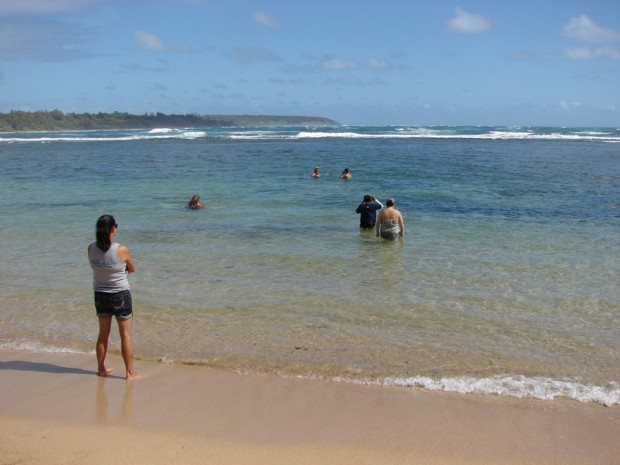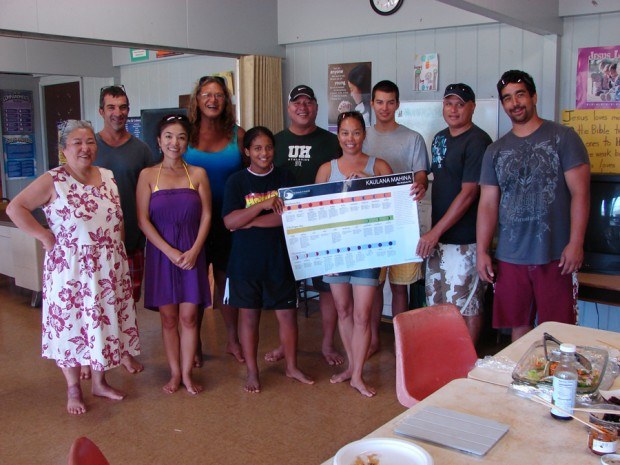Re-learning the umu in Hawaiian culture
ANAHOLA — A cross-cultural event recently celebrated the return of traditional food sourcing and preparation in the interest of health and heritage.
The Hawaiian umu is an eco-friendly fish trap that was widely used until the middle of the 20th century. Today, it is inspiring this generation to celebrate the umu’s heritage but also its practical use.
“Inspired by the ocean, and strengthened by ancestral fishing knowledge, this is one of several ideas to help Hawaiian immersion programs get back on their feet at local schools and community centers,” said Kamealoha Smith, a Hawaiian language and culture instructor with the Ke Kaiaulu O Anahola charter school.
“There are many variations,” Smith said. “The umu is constructed differently depending on the conditions of the reef or beaches.”
Participants gathered Tuesday morning at Anahola Beach Park to hold a ceremony for their first umu project, which was completed about 50 yards offshore. Following a shoreline song the participants waded out to the umu.
Smith said the goal is to make the umu project safe and for the students to get the most out of it. He enlisted the help of elders with a living memory of the umu.
Sharon Pomroy learned about the umu as a girl on O‘ahu in the 1950s. An elder relative maintained the one his own father built in the 1930s.
“It was from that point that the umu stuck in my head and I have always wanted to try it,” she said. “I have done small ones in streams to watch how it works, but this is the first one that I have done in the ocean.”
The umu is rectangular structure made of large and small stones built to be around 4 feet by 8 feet, with walls creating an underwater chamber. It has an opening at either end to let the current run through. Small fish hide and feed on the growth inside. They attract larger predator fish who also enter the chamber but can’t reach all the hiding spaces.
Pomroy said umus work best on coastlines where fresh water runoff creates an ideal salinity and a nutrient coastline that Hawaiians describe as mulivai. This assists the growth of desired foods that help small fish flourish and create an abundance of sea life inside the reef.
One thing Pomroy discovered was that ocean rocks are already teeming with sea life underneath. To avoid disturbing existing sea life, she builds the umu using rocks from the shore.
The methods to get fish from an umu vary, but Pomroy said most involve using a woven basket called an umeke. It is placed on the open end while the other is closed or stirred to encourage fish out into the basket.
The small fish go through the basket like a sieve. But a large fish will be trapped and can be harvested.
There is nothing detrimental to sea life or the ecosystem about the umu, Pomroy said. It simply fell out of practice as families stopped gathering for themselves and began shopping at the markets.
Kumu Mikala, a Hawaiian language teacher at Kapa‘a High School, said her students built a mock umu with Pomroy, using rocks and sand to see how it worked before building one in the water. Now they want to build umus on other areas of the island.
“I think it is very exciting,” Mikala said. “We started to put one together and the fish came the very next day.”
Erin Cobb-Adams, an engineer who brought his talents as a tutor and teacher to Ke Kaiaulu O Anahola, said his own great-grandfather used these techniques and told of them in recordings before he passed away.
“The umu is essentially a fish house that brings everything closer to shore,” Cobb-Adams said.
He said the umu is a mini ecosystem that operates like a fish pond. The difference is that it draws fish closer to shore with an exchange of predators at the gates.
“We want to educate the community to use this resource in the correct way so that it doesn’t become viewed just as a pile of rocks,” Cobb-Adams said. “It is traditional resource management.”
Adam Prall, the technology director and language student at Ke Kaiaulu O Anahola, said the volunteers run nine traditional projects. They blend contemporary and Hawaiian science to teach about the weather and coastal conditions, using the etymology of the area to help restore place names.
“Its a natural evolution of different cultural combinations,” Prall said. “There are many opinions about how the umu were used and who built them in different places.”
Two Ke Kaiaulu O Anahola students, Lou Lani, 14, and Jordan Guerrero, 17, said the experience was educational and meaningful.
“I go out there about twice a week with the group, and I’m trying to get my friends to come,” Lani said. “It’s going to be knowledge for surviving if there is no food on land.”
Guerrero said swimmers often don’t recognize the umu for what it is and knock it over by standing on it. He said they are creating a sign to educate people about the history of the umu and ask them to leave it alone.
“It was a way for the kupunas to get food,” he said. “They could just wade out to the umu.”
His father, Kaleo Guerrero, is employed at the St. Regis Princeville Resort and said he is interested in studying the umu to see if it would fit in its reef education programs. He said it sounds like a good fit with current marine life programs and would add the culture of harvesting.
“It’s a great reef system and the perfect spot to do that,” Guerrero said.
Once Tuesday’s ceremony was completed, the group went to the Anahola Church where Keiko Takano of Kanagawa, Japan, prepared a fresh aki in the poki style, using a traditional Japanese dressing of miso, sesame and ginger.
Takano said the year-long process to make a miso base starting with rice is one example of food and the resurgence of cultural importance. She compared it to Hawai‘i’s taro culture.
Takano sensei runs the Ocean Foods school to help people prepare food in a healthy and traditional way. The school recently opened a restaurant within the school as more people embrace natural foods.
She said the project made it possible to achieve her dream of serving as a cultural bridge between Japan and Hawai‘i.
Akiko Hosaka said the umu shows the value of traditional ways to a new generation. She has been on Kaua‘i for more than a decade and said it is good when something like this can be learned and appreciated across cultural boundaries.
“It is a way to help all people that come here to experience something of the culture so that they can respect it and the people,” she said.
Smith said he was fortunate to spend a lot of time with his grandparents in Anahola. They had a Hawaiian language household and he was steeped in cultural traditions.
Smith went on to become teacher certified in Hawaiian immersion and Japanese language. He has a master’s degree from University of Hawai‘i Manoa, and also studied at Nagasaki Weslyan University’s Japanese Language Institute.
He said surveys show that 15 percent of Anahola residents have some level of Hawaiian language. The sampling is small but he said the response has been positive and inspires them to produce a body of knowledge of lesser-known communities outside the tourism centers.
Ke Kaiaulu O Anahola focuses on language but Smith said it also includes Ku‘ana ‘Epekema, the traditional epistemology-based science of Hawai‘i. He said the school differs from others that teach more abstract art and cultural elements.
“The mission of our program is to increase the number of places on Hawai‘i where there the traditional ways of knowing, thinking and speaking are relevant and meaningful in today’s society and economy,” Smith said. “The economy is in there to show that you can get some type of job with study that is steeped in traditional language and culture.”
The school recently completed a Hawaiian moon calendar with the help of Kumu Mikala and her students. The students also created a Wahi Pana Hawaiian language book of sacred place names.
The school also runs a transitional job and life skills program in Hawaiian for inmates at Kaua‘i Community Correctional Center. The projects are possible with assistance from the Office of Hawaiian Affairs and the Castle Foundation.
∫ Tom LaVenture, staff writer, can be reached at 245-3681 (ext. 224) or by emailing tlaventure@thegardenisland.com.



